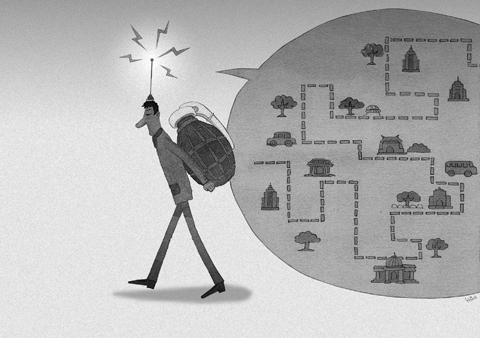The rapid proliferation of military drone planes and armed robots should be subject to international legal controls, conferences in London and Berlin will argue this month.
Public awareness of attacks by unmanned aerial vehicles (UAVs), such as Reapers and Predators, in Afghanistan and Pakistan has grown, but less is known of the evolution of unmanned ground vehicles (UGVs).
Two conferences — Drone Wars in London on Saturday and a three-day workshop organized by the International Committee for Robot Arms Control (ICRAC) in Berlin from tomorrow until Wednesday — will hear calls for bans and for tighter regulation under international arms treaties.

British academics and policy experts, Red Cross representatives, peace activists, military advisers, human rights lawyers and those opposed to the arms trade are participating in the German meeting.
The development of what is known as “autonomous targeting” — where unmanned planes and military ground vehicles are engineered to lock automatically on to what their onboard computers assume is the enemy — has heightened concern.
Research is under way at enabling UAVs and UGVs to work in collaborative swarms, ensuring each machine selects a different target. This has reinforced fears that UAV strikes along the Afghanistan-Pakistan border and in the Horn of Africa — or wherever future wars are fought — will increase death tolls.
British air force (RAF) pilots already operate armed drones from Creech US air force base in the Nevada desert — 13,000km away from the frontline where they release Hellfire missiles and Paveway bombs against Taliban targets.
Through a freedom of information request submitted to the UK Ministry of Defence, the UK-based Fellowship of Reconciliation — the group organizing the Drone Wars conference — found that as of April this year, RAF-controlled Reapers had opened fire on 84 occasions so far this year.
Defense equipment manufacturers insist that there is always “a man in the [control] loop” to authorize operations and that they are far less indiscriminate than the high level air force saturation bombing that occurred in World War II. Since there is no onboard pilot at risk, so the argument goes, they do not always have to fire first.
Critics highlight the number of civilian casualties in supposedly “surgical strike” raids, alleging that reliance on remote screens may induce a dehumanizing electronic games mentality in operators, and fear that such clandestine missions could lower the threshold for war — for example in Yemen and Somalia where the US is not involved in any formal conflict.
Philip Alston, a UN human rights special rapporteur, warned last autumn that US use of drones to kill militants in Afghanistan and Pakistan may violate international law. He called on the US to explain the legal basis for killing individuals with its drones.
“More than 40 countries have robotic programs now,” said Noel Sharkey, professor of robotics and artificial intelligence at Sheffield University, England, who is speaking at both conferences this month. “Even Iran has launched a UAV bomber with a range of several hundred miles. These [robotic] systems are difficult to develop, but easy to copy. In the [United ] States, a large proportion of robot making is being moved to Michigan to compensate for the decline in the car industry. Increasingly, [the manufacturers] are talking about the ‘man on the loop,’ where one person can control a swarm of robots. Our biggest concern for the future is autonomous systems that [select] targets themselves.”
For many scientists, the future potential is most alarming. David Webb, a professor of engineering at Leeds Metropolitan University, England, vice-chair of the UK Campaign for Nuclear Disarmament (CND) and an expert on the militarization of space, addressed the Drone Wars conference in London. “We are only just starting to become aware of the wider issues,” he said. “Robots are [being developed] to make some decisions for themselves. If they kill somebody by mistake, do you put the robot on trial? The idea of having networked UAVs that work in swarms and could be armed has all sorts of implications.”
Dr Steve Wright, a lecturer in applied global ethics at Leeds Metropolitan University who will speak at an ICRAC workshop on the dangers of terrorists obtaining drones, said: “We need a new treaty to limit proliferation. All the arms fairs now are selling UAVs. It’s naive to think they will remain in the hands of governments.”
The UK government has defended the use of RAF-controlled UAVs in Afghanistan. An spokesperson said: “The rules of engagement used for Reaper weapon releases are the same as those used for manned combat aircraft: The weapons are all precision guided and every effort is made to ensure the risk of collateral damage and civilian casualties is minimized. This may include deciding not to release a weapon.”

China has not been a top-tier issue for much of the second Trump administration. Instead, Trump has focused considerable energy on Ukraine, Israel, Iran, and defending America’s borders. At home, Trump has been busy passing an overhaul to America’s tax system, deporting unlawful immigrants, and targeting his political enemies. More recently, he has been consumed by the fallout of a political scandal involving his past relationship with a disgraced sex offender. When the administration has focused on China, there has not been a consistent throughline in its approach or its public statements. This lack of overarching narrative likely reflects a combination
Behind the gloating, the Chinese Nationalist Party (KMT) must be letting out a big sigh of relief. Its powerful party machine saved the day, but it took that much effort just to survive a challenge mounted by a humble group of active citizens, and in areas where the KMT is historically strong. On the other hand, the Democratic Progressive Party (DPP) must now realize how toxic a brand it has become to many voters. The campaigners’ amateurism is what made them feel valid and authentic, but when the DPP belatedly inserted itself into the campaign, it did more harm than good. The
US President Donald Trump’s alleged request that Taiwanese President William Lai (賴清德) not stop in New York while traveling to three of Taiwan’s diplomatic allies, after his administration also rescheduled a visit to Washington by the minister of national defense, sets an unwise precedent and risks locking the US into a trajectory of either direct conflict with the People’s Republic of China (PRC) or capitulation to it over Taiwan. Taiwanese authorities have said that no plans to request a stopover in the US had been submitted to Washington, but Trump shared a direct call with Chinese President Xi Jinping (習近平)
Workers’ rights groups on July 17 called on the Ministry of Labor to protect migrant fishers, days after CNN reported what it described as a “pattern of abuse” in Taiwan’s distant-water fishing industry. The report detailed the harrowing account of Indonesian migrant fisher Silwanus Tangkotta, who crushed his fingers in a metal door last year while aboard a Taiwanese fishing vessel. The captain reportedly refused to return to port for medical treatment, as they “hadn’t caught enough fish to justify the trip.” Tangkotta lost two fingers, and was fired and denied compensation upon returning to land. Another former migrant fisher, Adrian Dogdodo